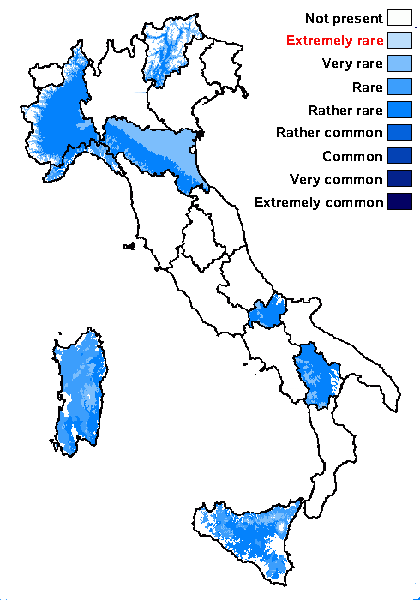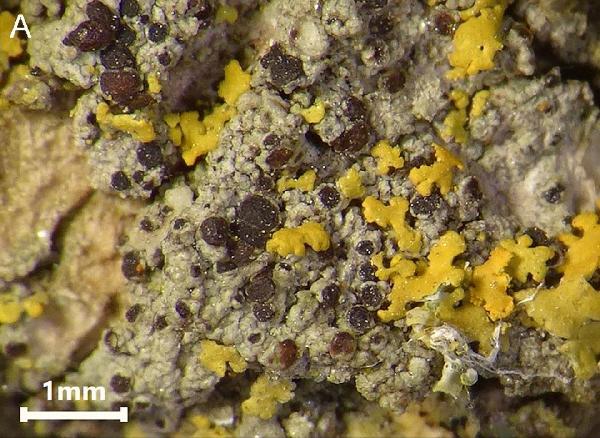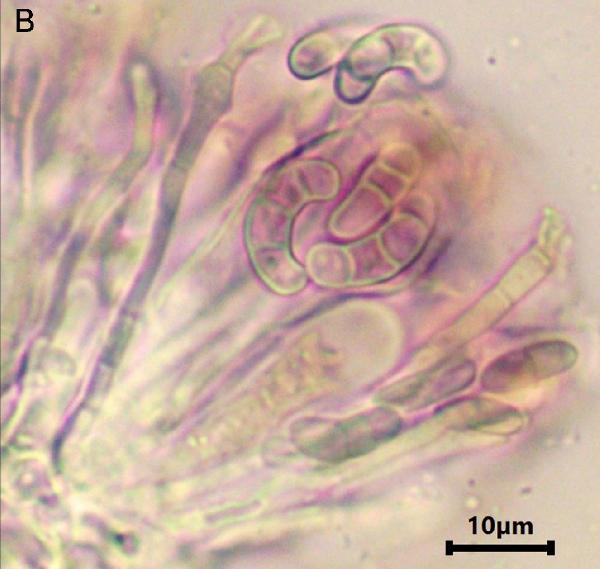Lecania koerberiana J. Lahm
in Körber, Parerga Lichenol.: 68, 1859.
Synonyms: Lecania opuntiae Bagl.
Distribution: N - TAA (Nascimbene & al. 2007b), Piem (TO 3018), Emil (Nimis & al. 1996, Fariselli & al. 2020), Lig. C - Mol (Nimis & Tretiach 1999, Caporale & al. 2008), Sar (Rizzi & al. 2011, Neuwirth 2018, Di Nuzzo & al. 2022). S - Bas (Nimis & Tretiach 1999), Si (Grillo 1998, Grillo & Caniglia 2004).
Description: Thallus crustose, endosubstratic to thinly episubstratic, farinose, whitish grey to pale grey. Apothecia lecanorine, immersed to adnate, 0.3-0.6 mm across, with a reddish brown to blackish, epruinose disc and a thin, often finally excluded thalline margin. Thalline exciple thin, ecorticate, filled with algae at least in lower part; proper exciple thin; epithecium brownish; hymenium colourless, I+ blue turning reddish; paraphyses weakly coherent, the apical cells to 7 µm wide; hypothecium colourless. Asci 8-spored, clavate, with a K/I+ blue apical dome penetrated by a narrow, K/I- apical cushion surrounded by a narrow, deeply K/I+ blue zone, the wall K/I- but surrounded by an I+ red-brown, K/I+ blue outer layer, the ocular chamber relatively small, Biatora-type. Ascospores 3-septate, usually not constricted at septa, hyaline, narrowly ellipsoid, straight or (mostly) slightly curved, 12-15 x 4-5 µm, without a gelatinous perispore. Photobiont chlorococcoid. Spot tests: thallus K-, C-, KC-, P-, UV-. Chemistry: without lichen substances.Note: a mild-temperate species found on nutrient-rich or -enriched bark; closely related to L. fuscella.
Growth form: Crustose
Substrata: bark
Photobiont: green algae other than Trentepohlia
Reproductive strategy: mainly sexual
Commonnes-rarity: (info)
Alpine belt: absent
Subalpine belt: absent
Oromediterranean belt: absent
Montane belt: very rare
Submediterranean belt: rather rare
Padanian area: very rare
Humid submediterranean belt: rare
Humid mediterranean belt: absent
Dry mediterranean belt: absent

Predictive model
Herbarium samples
Growth form: Crustose
Substrata: bark
Photobiont: green algae other than Trentepohlia
Reproductive strategy: mainly sexual
Commonnes-rarity: (info)
Alpine belt: absent
Subalpine belt: absent
Oromediterranean belt: absent
Montane belt: very rare
Submediterranean belt: rather rare
Padanian area: very rare
Humid submediterranean belt: rare
Humid mediterranean belt: absent
Dry mediterranean belt: absent

Predictive model
| Herbarium samples |
 INDEX FUNGORUM
INDEX FUNGORUM
 GBIF
GBIF
 DOLICHENS
DOLICHENS






